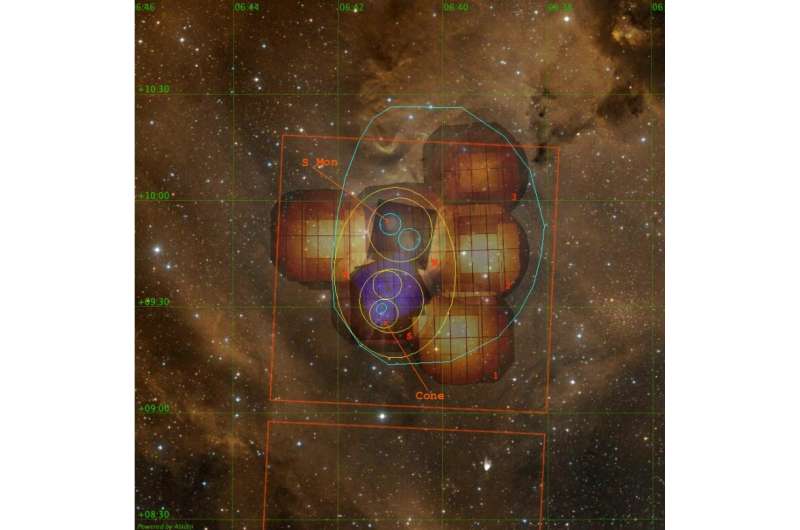November 25, 2022 report
Structure of the cluster NGC 2264 explored by researchers

By analyzing the data from ESA's XMM-Newton and Gaia satellites, astronomers have investigated a young star cluster known as NGC 2264. Results of the study, published November 16 on the arXiv pre-print repository, shed more light on the structure of this object and could be helpful in advancing our knowledge about stellar evolution.
In general, star clusters (SCs) are large gravitationally bound groups of stars. They are perceived as important laboratories for studying the evolution of stars and the clusters themselves. SCs are also good tracers for exploring the structure of the Milky Way.
NGC 2264 (also known as Dahm 2008) is a young (estimated to be 3–5 million years old) stellar cluster located some 2,480 light years away, containing more than a thousand stellar-mass members. Due to its proximity and the fact that the cluster's activity is still ongoing within its parental cloud, it is one of the most accessible star-forming regions in the Milky Way.
So a group of astronomers led by Ettore Flaccomio of the Palermo Astronomical Observatory in Italy studied NGC 2264 in detail. For this purpose they analyzed new X-ray data obtained with the XMM-Newton and data from Gaia's EDR3 (Early Data Release 3). The study was complemented by datasets from various catalogs.
"We revisit the structure, dynamics, and star-forming history of NGC 2264 in order to advance our understanding of the processes that lead from molecular clouds to protostars, stellar associations, and the evolution of both," the researchers wrote in the paper.
The available data allowed the team to create a catalog of 2,257 candidate members of NGC 2264—therefore almost twice as large as previous catalogs. Afterward, the astronomers analyzed the spatial distribution of these objects and defined new substructures in the cluster.
Based on the surface density map of candidate members, the scientists identified four new substructures and designated them: compact S Mon(C) region, embedded Cone (C-IR), Extended Halo and the S Mon(ref) region. It turned out that the Extended Halo contains almost 80 percent of all the candidate members—1,794 objects. It was added that S Mon(C) is possibly older than the surrounding region or has a distinctly lower fraction of stars with disks and undergoing accretion.
The authors of the paper underlined that the identification of such a high number of candidate members in the Extended Halo significantly enlarges the known extent of NGC 2264.
"The cluster is likely even broader, but a less contaminated membership is needed in order to characterize the outer population," the researchers explained.
Summing up the results, the astronomers noted that in general the stars in the southern regions of NGC 2264 are younger than those close to S Mon—a larger substructure containing the newly identified S Mon(C)—in the north. They assume that star formation in this cluster started about four million years ago in the S Mon region and extended progressively toward the south, where it is presently continuing.
According to the authors of the study, the findings show that NGC 2264 is not dynamically relaxed and its present configuration is due to multiple dynamical processes. They added that this SC is therefore one of the best sites to investigate the formation mechanisms of stars and clusters.
More information: E. Flaccomio et al, Spatial and dynamical structure of the NGC 2264 star-forming region, arXiv (2022). DOI: 10.48550/arxiv.2211.09000
Journal information: arXiv
© 2022 Science X Network





















